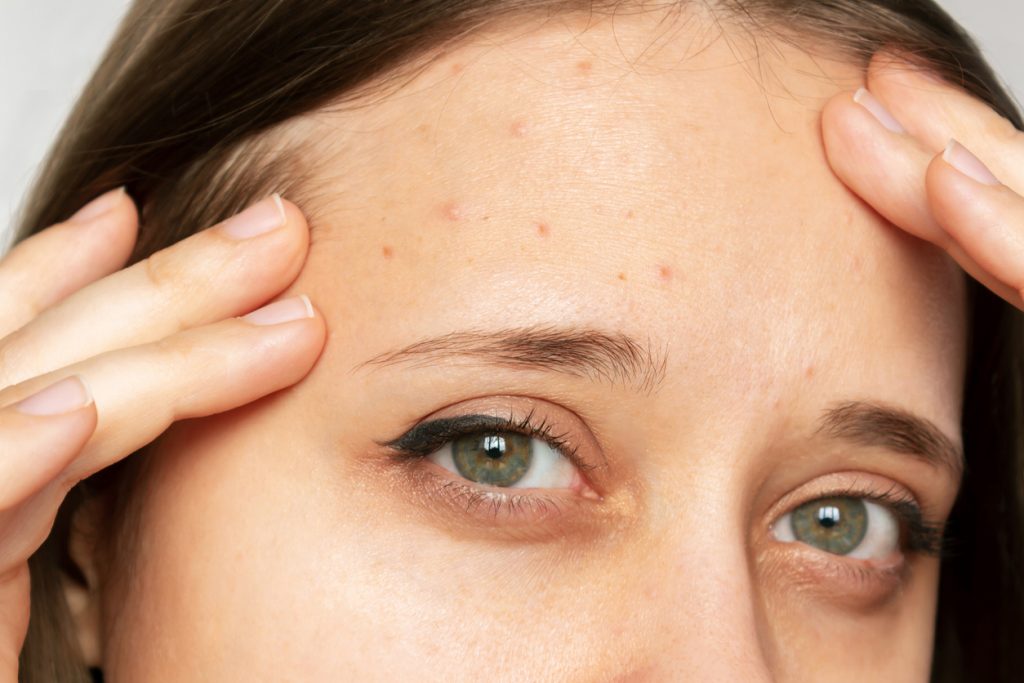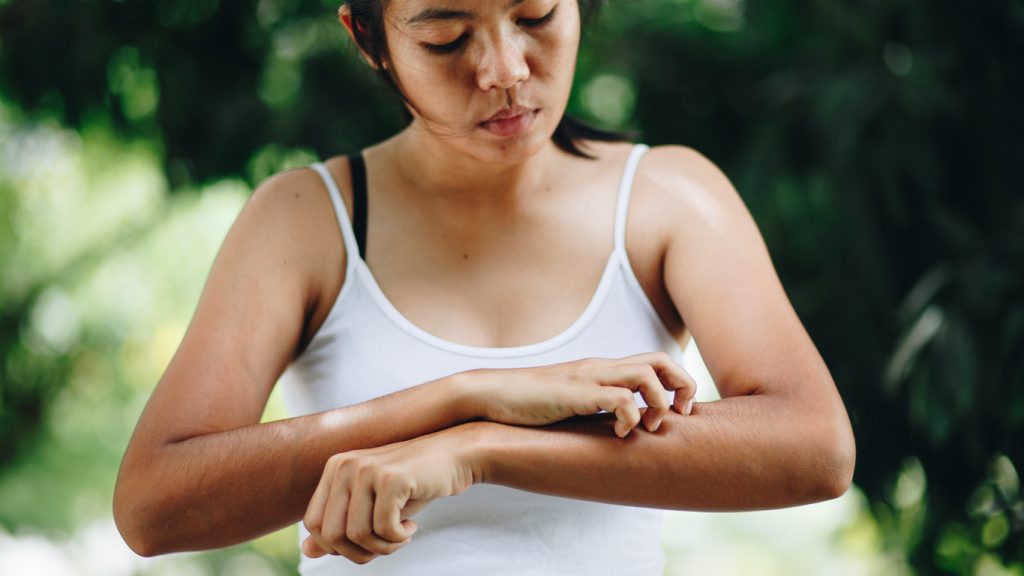Acne, eczema, hives: Your complete guide to skin conditions
If you suffer from a skin condition, you’re not alone – around 1 million Australian (4% of the population) suffer from a long-term condition of the skin. Whether it’s on your face or your body, skin conditions can lead to physical, emotional and psychological trauma.
Here are some common conditions and how to manage them, plus how to take care of your skin to avoid developing one in the first place.

How to care for your skin
The skin is your largest organ so you need to take care of it. While skin care will vary between skin types and body parts – your face, for example, may require a more intense care routine than your stomach – there are some general steps to follow to keep your skin healthy.
- Stay hydrated: The outermost layer of your skin holds moisture to flush away toxins and carry nutrients to cells. Skin that is well-hydrated is also less sensitive to irritants and germs.
- Get the recommended amount of nightly sleep: Enhanced blood-flow to your skin during sleep not only helps stave off dark circles under your eyes, but also gives your skin time to rebuild its collagen and repair damage from UV exposure, reducing wrinkles and age spots.
- Exercise regularly: That flush you get when exercising? That’s a boost in blood-flow, drawing oxygen in and free radicals away from the skin. Keeping active also helps decrease stress and improve sleep quality.
- Use a moisturiser. It doesn’t matter whether your skin is dry, oily, mature or acne prone, using a moisturiser is essential to help prevent dry, flaky skin and prevent fine lines and wrinkles.
- Protect yourself from the sun: Wear sunscreen, seek shade and wear long, protective clothing. The sun’s rays can not only damage your skin and cause wrinkles and discolouration, but can also lead to more serious health concerns, like skin cancer.
- Don’t smoke. Smoking narrows the tiny blood vessels in the outermost layers of skin, which decreases blood flow and makes skin paler. This also depletes the skin of oxygen and nutrients that are important to skin health, contributing to wrinkles and making you look older than you are.
- Be gentle. Daily cleansing, buffing and shaving can take a toll on your skin. To keep it gentle, limit bath time (soaking removes oils from your skin), avoid strong soaps (that can strip oil from your skin), shave carefully (always use shaving gel or cream and a sharp razor), and pat your skin dry, so moisture remains in your skin.
- Eat a healthy diet. Eat plenty of fruits, vegetables, whole grains and lean proteins, to protect your skin from cellular damage caused by free radicals and get your daily recommended intake of vitamins, minerals and healthy oils.
- Manage stress. Stress causes your body to make hormones like cortisol, which tells glands in your skin to make more oil. Oily skin is more prone to acne and other skin problems.
If you are experiencing symptoms, you should speak to a doctor to find out the right treatment for you. You can request a telehealth consultation with one of our Australian-registered doctors from anywhere in Australia, seven days a week.

What is acne?
While you can often feel very self-conscious and depressed when you have acne, take comfort in the fact that you are not alone. Acne – in one of its various forms – affects 85% of Australians aged 15-24 years old. Although it’s most common during teenage years, it can impact some people well beyond their twenties.
Acne occurs when hair follicles under the skin become clogged. Sebum (the oil that helps keep skin from drying out) and dead skin cells plug the pores, which leads to outbreaks of pimples. Most often, the outbreaks occur on the face but can also appear on the back, chest, and shoulders.
Hormone changes related to puberty, gender or pregnancy; family history; certain medications; and age can all contribute to the onset of acne. Meanwhile your diet, stress, pressure from clothes, environmental irritants, squeezing or picking, and scrubbing your skin can make it worse.
What are eczema and psoriasis?
If you didn’t know any better, you might think eczema and psoriasis were the same thing. These two common skin conditions have a similar look at the surface – they can both cause a rash (patches of red, raised, itchy skin), and they can both appear in the same parts of the body. Deep down, however, they are fundamentally different.
Psoriasis is an autoimmune disease that causes dry, itchy, and thick patches of skin because your skin cells grow too fast. Eczema is a chronic skin condition that causes red, itchy and dry rashes on the skin. It’s thought both genetic and environmental factors play a role in triggering the rash.

What is ringworm?
Despite its name, there is no worm involved in ringworm – it actually gets its name from its appearance. Caused by a fungal infection, ringworm presents itself on your skin as an itchy, circular rash with clearer skin in the middle. It can be red and scaly, and lead to cracked skin and hair loss.
Ringworm is a contagious fungal infection caused by common mould-like parasites that live on the cells in the outer layer of your skin.
What are shingles and chickenpox?
Chickenpox and shingles are both caused by a reaction to the same virus, herpes zoster virus (also known as the Varicella-Zoster virus). But they are not the same illness.
Chickenpox is usually a milder viral illness that affects children. It begins with a sudden onset of slight fever, runny nose, feeling generally unwell and a skin rash. The rash usually begins as small, itchy lumps that turn into blisters and then scabs.
Shingles results from a reactivation of the virus long after the chickenpox illness has disappeared, and usually occurs in adulthood. It’s characterised by a painful chickenpox-like rash on a small area of skin – the pain and tingling can persist for weeks or months after the rash has cleared.
What are hives (urticaria)?
Up to 20 per cent of people will develop hives at some time during their life. Many people mistake hives for mosquito bites, as they appear as pink or red itchy rashes consisting of blotches or raised red lumps (wheals) on the skin. They range from the size of a pinhead to the size of a dinner plate. Essentially, they’re caused by certain cells in our body releasing histamine, which irritates nerve endings causing skin irritation and itchiness, triggering redness and swelling.
Swellings usually disappear within minutes to hours in one spot, but may come and go for days or weeks at a time, sometimes longer.
If you are experiencing symptoms, you should speak to a doctor to find out the right treatment for you. You can request a telehealth consultation with one of our Australian-registered doctors from anywhere in Australia, seven days a week.
To speak with an InstantScripts Doctor:
Request a ConsultationIf you have run out of your script:
Request a ScriptThis article is written by Natasha Dragun who has been writing about health and wellness for more than 20 years.
© InstantScripts
Level 8 / 637 Flinders St.,
Docklands VIC 3008

